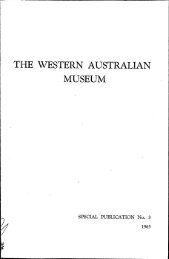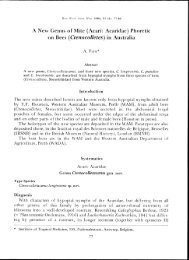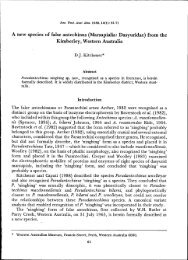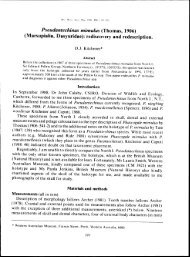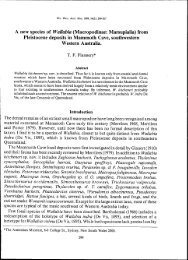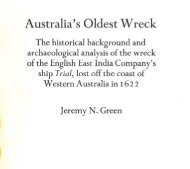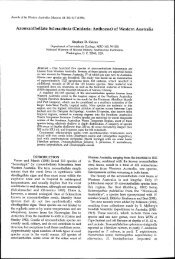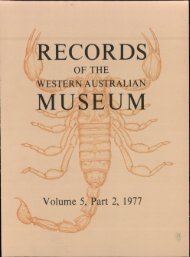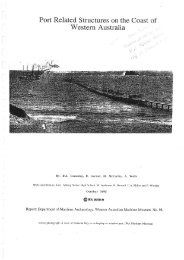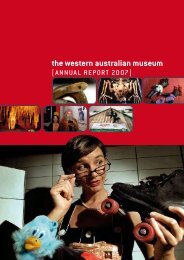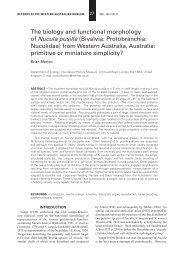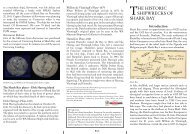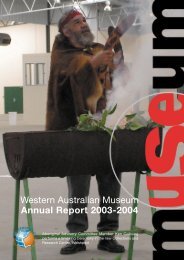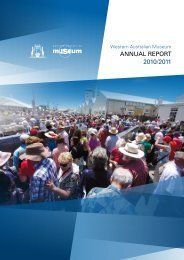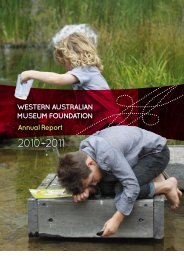No. 237 Maritime Archaeology in the People's Republic of China ...
No. 237 Maritime Archaeology in the People's Republic of China ...
No. 237 Maritime Archaeology in the People's Republic of China ...
Create successful ePaper yourself
Turn your PDF publications into a flip-book with our unique Google optimized e-Paper software.
At <strong>the</strong> stem before <strong>the</strong> first bulkhead <strong>the</strong>re is <strong>the</strong> mast step<br />
for <strong>the</strong> foremast, 84 cm long, 21 cm wide and 14 cm thick.<br />
Two holes for <strong>the</strong> tabernacle <strong>of</strong> <strong>the</strong> mast were 14 x 7 cm <strong>in</strong><br />
size, 5 cm <strong>in</strong> depth with 13 cm <strong>in</strong>terval were opened <strong>in</strong> <strong>the</strong><br />
middle <strong>of</strong> <strong>the</strong> step. The step is made out <strong>of</strong> a complete piece<br />
<strong>of</strong> camphor wood.<br />
The mid-mast had a relatively large mast step at <strong>the</strong> back<br />
part <strong>of</strong> <strong>the</strong> fourth compartment from <strong>the</strong> fore part <strong>of</strong> <strong>the</strong> ship.<br />
This was made out <strong>of</strong> several k<strong>in</strong>ds <strong>of</strong> wood, <strong>the</strong> step was 105<br />
cm long, 25 cm wide and 18 cm thick. There were two holes for<br />
mast tabernacle which were 15 x 8 cm <strong>in</strong> size, 5 cm <strong>in</strong> depth<br />
were opened <strong>in</strong> <strong>the</strong> middle <strong>of</strong> <strong>the</strong> step. Because <strong>the</strong> stern <strong>of</strong><br />
<strong>the</strong> ship was broken, <strong>the</strong>re was no evidence for <strong>the</strong> existance<br />
an aft mast step, however, given <strong>the</strong> proportions <strong>of</strong> <strong>the</strong> vessel<br />
and <strong>the</strong> location <strong>of</strong> <strong>the</strong> mast steps it is likely that <strong>the</strong>re was at<br />
least one o<strong>the</strong>r mast, possibly stepped on <strong>the</strong> deck.<br />
<strong>No</strong> complete components <strong>of</strong> <strong>the</strong> rudder were found. A<br />
rema<strong>in</strong><strong>in</strong>g piece <strong>of</strong> timber, found at stern <strong>of</strong> <strong>the</strong> ship, was<br />
186 cm long, 42 cm wide and 18 cm thick with a hole <strong>of</strong> 26<br />
cm <strong>in</strong> diameter <strong>in</strong> <strong>the</strong> middle and is thought to be part <strong>of</strong> <strong>the</strong><br />
rudder.<br />
At <strong>the</strong> outer side <strong>of</strong> <strong>the</strong> jo<strong>in</strong>t between <strong>the</strong> seventh and<br />
eighth strakes, a semi-circular protect<strong>in</strong>g strake or whale was<br />
attached, 710 cm long, 14 cm wide and 9 cm thick. Both ends<br />
were broken, <strong>the</strong> whale tapered towards <strong>the</strong> bow (10 x 4 cm).<br />
The whale was made <strong>of</strong> cypress wood and was nailed to <strong>the</strong><br />
hull by two rows nails with 4–50 cm <strong>in</strong>tervals.<br />
The J<strong>in</strong>an Ship, Shandong<br />
This vessel was discovered <strong>in</strong> 1956 <strong>in</strong> <strong>the</strong> prov<strong>in</strong>ce <strong>of</strong> Shandong<br />
and is now preserved <strong>in</strong> <strong>the</strong> Shandong Prov<strong>in</strong>cial Museum at<br />
J<strong>in</strong>an (Fig. 00). A very brief report <strong>in</strong> English has been published<br />
by Needham et al. (1971). The vessel is about 20 m long by<br />
3.5 m wide, transom-ended with 13 compartments. The vessel<br />
is flat bottomed and has a sharp ch<strong>in</strong>e, thus typical <strong>of</strong> <strong>the</strong> river<br />
and <strong>No</strong>rth Ch<strong>in</strong>a Seas design. The ship dates from <strong>the</strong> 14th<br />
century: an anchor was dated 1372 and a bronze gun 1377. It<br />
is thought to have been a government river patrol boat.<br />
The Sh<strong>in</strong>an Ship<br />
The Sh<strong>in</strong>an ship has been widely described, ma<strong>in</strong>ly for<br />
its exotic cargo <strong>of</strong> Ch<strong>in</strong>ese and Korean ceramics (FIGS).<br />
Relatively little has been published about <strong>the</strong> hull structure<br />
which is both <strong>in</strong>terest<strong>in</strong>g and important to <strong>the</strong> understand<strong>in</strong>g<br />
<strong>of</strong> Ch<strong>in</strong>ese-built vessels (see Kim 1980, Green (1983), Green<br />
& Kim (1989), H<strong>of</strong>fmann et al (1991), Mokpo Conservation<br />
and Restoration Centre (1985)). The vessel has been dated to<br />
about 1323 from artefacts and co<strong>in</strong>s. The rema<strong>in</strong>s <strong>of</strong> <strong>the</strong> ship<br />
<strong>in</strong>clude <strong>the</strong> keel, about 14 strakes <strong>of</strong> <strong>the</strong> starboard side and six<br />
strakes <strong>of</strong> <strong>the</strong> port side <strong>of</strong> <strong>the</strong> ship, part <strong>of</strong> <strong>the</strong> transom bow<br />
and a small section <strong>of</strong> <strong>the</strong> stern transom.<br />
The hull <strong>of</strong> <strong>the</strong> ship is rabbeted cl<strong>in</strong>ker construction with<br />
evidence <strong>of</strong> sheath<strong>in</strong>g. In <strong>the</strong> fore part <strong>of</strong> <strong>the</strong> vessel <strong>the</strong> rabbeted<br />
cl<strong>in</strong>ker changes to rabbeted carvel allow<strong>in</strong>g a flush jo<strong>in</strong>t on <strong>the</strong><br />
transom bow. The strakes are butt-jo<strong>in</strong>ted. In most cases <strong>the</strong><br />
butt-jo<strong>in</strong>t is a lap jo<strong>in</strong>t, but on <strong>the</strong> garboard strake and on at<br />
least one o<strong>the</strong>r place <strong>the</strong> jo<strong>in</strong>t is a tongue and groove jo<strong>in</strong>t. On<br />
<strong>the</strong> <strong>in</strong>ternal face <strong>of</strong> <strong>the</strong> butt-jo<strong>in</strong>ts <strong>the</strong>re are butt plates which<br />
sit over <strong>the</strong> top <strong>of</strong> <strong>the</strong> jo<strong>in</strong>ts and clamp <strong>the</strong>m toge<strong>the</strong>r. In some<br />
Figure 40.<br />
The J<strong>in</strong>an ship show<strong>in</strong>g <strong>the</strong> bow from <strong>the</strong> port side.<br />
Figure 41. The J<strong>in</strong>an ship show<strong>in</strong>g <strong>the</strong> bow from <strong>the</strong> starboard<br />
side.<br />
cases <strong>the</strong>se butt plates are set under a frame, <strong>in</strong>dicat<strong>in</strong>g that <strong>the</strong><br />
frames were put <strong>in</strong> place after <strong>the</strong> completion <strong>of</strong> <strong>the</strong> plank<strong>in</strong>g.<br />
The strakes are rabbeted cl<strong>in</strong>ker construction, with <strong>the</strong> rabbet<br />
cut out <strong>of</strong> <strong>the</strong> uppermost plank, on <strong>the</strong> lower <strong>in</strong>side edge.<br />
The seven bulkheads are supported by frames and stiffeners.<br />
Bulkheads forward <strong>of</strong> <strong>the</strong> mast step are supported on <strong>the</strong> aft<br />
side with frames and on <strong>the</strong> forward side by stiffeners—aft<br />
<strong>of</strong> <strong>the</strong> mast step <strong>the</strong> reverse is true. The stiffeners, which are<br />
po<strong>in</strong>ted wooden pegs, penetrate each strake from <strong>the</strong> outside<br />
<strong>of</strong> <strong>the</strong> hull plank<strong>in</strong>g through <strong>the</strong> middle <strong>of</strong> <strong>the</strong> plank and are<br />
not rebated <strong>in</strong>to <strong>the</strong> bulkhead. Thus <strong>the</strong> stiffeners locate <strong>the</strong><br />
opposite side <strong>of</strong> <strong>the</strong> bulkhead to <strong>the</strong> frames and are attached<br />
to <strong>the</strong> face <strong>of</strong> <strong>the</strong> bulkhead.<br />
There is a fore and a ma<strong>in</strong> mast step, a structure that is<br />
possibly part <strong>of</strong> <strong>the</strong> deck<strong>in</strong>g <strong>of</strong> <strong>the</strong> ship and evidence for a<br />
water tank <strong>of</strong> some sort forward <strong>of</strong> <strong>the</strong> ma<strong>in</strong> mast. A research<br />
model has been built by <strong>the</strong> Mokpo Conservation and<br />
Restoration Centre at a scale <strong>of</strong> 1:5 based on measurements<br />
made <strong>of</strong> <strong>the</strong> hull timbers. This model raises a number <strong>of</strong><br />
complex and <strong>in</strong>terest<strong>in</strong>g problems, however, <strong>the</strong> model has<br />
some limitations. Firstly, because <strong>of</strong> <strong>the</strong> poor visibility on <strong>the</strong><br />
wreck site, it was not always possible to establish <strong>the</strong> exact<br />
orientation <strong>of</strong> <strong>the</strong> pieces, thus <strong>in</strong> some cases <strong>the</strong>ir relationship<br />
is uncerta<strong>in</strong>. Additionally, <strong>the</strong> plans <strong>of</strong> <strong>the</strong> timbers were made<br />
from <strong>in</strong>dividual measurements made on <strong>the</strong> timbers, but not<br />
21



